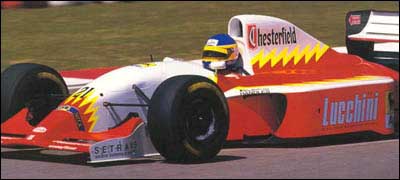|
THE CONSTRUCTION OF THE MODERN FORMULA ONE CAR |
The aim of this page is to have a brief look at some of the manufacturing processes involved in the construction of a formula one car. Please note that this information is based on the Lola BMS-Ferrari T93/30 (1993), so may not truly represent the processes currently employed in the industry.

The Lola BMS-Ferrari T93/30. Picture from http://digilander.iol.it/bigmat/img93.html used without permission.The first main stage in the production of the F1 car is to actually design it (see reference for more details and pictures!). This is a lengthy and complicated process, which is made harder by the fact that the car must comply with a strictly enforced set of regulations and crash tests laid out by international motorsports governing body FISA. Once the initial design is complete, a (1/3) scale model is constructed, which undergoes a series of extensive windtunnel tests in order to fine tune the aerodynamics of the car and the final shape of the chassis.
Once a final design is produced, the manufacture of the car can proceed. As mentioned previously, carbon fibre is used extensively in many components of the car. Unlike steel, carbon fibre has a non uniform structure, so by orientating the pieces of carbon fibre in particular directions, it is possible to direct externally applied forces across the chassis, thereby dissipating them. The Lola team used carbon-composite materials for the cars construction, which consists of the actual carbon fibres and a pre-impregnated epoxy resin. Within the main chassis, 2 layers of carbon fibre actually sandwich a layer of an aluminium honeycomb core material, which produces a very strong, rigid and lightweight structure.
The chassis is usually the first part of the car to be built, due to the amount of time required. The main chassis usually comprises of about 8 parts (panels). The first stage of the manufacturing process is to build a solid pattern (in effect a full size model of the specific panel), from which a mold for the panel is produced. The patterns for the Lola were computer cut from slabs of Ureol and hand finished. Once the pattern has been produced, the process of mold production can commence. The molds are constructed by laying a total of 10 layers of pre-preg (pre-impregnated with resin) carbon fibre on top of each pattern to produce the mold. The production of the mold takes place in several stages, involving vacuum treatments, debulking and heating processes. The mold then has to be thoughroughly cleaned and prepared for use.
The next stage is the carbon-composite layup, a lengthy, high precision and labour intensive process, the final product of which is the completed chassis panel. The panels are made from sheets of pre-cut, pre-preg carbon fibre, which are carefully laid inside the molds. It is vital that the carbon fibre follows the exact contours of the mold and that no pockets of air or other imperfections are introduced. It is also essential, as mentioned earlier, to orientate the carbon fibre sheets in pre determined directions in order to introduce the exact structural requirements of the specific panel. A total of 5 layers of carbon fibre are laid, forming the outer skin of the chassis (to achieve a final, cured thickness of 1mm, a total of 3-4 layers of carbon fibre must be laid down). The next stage of the process is to cure the carbon fibre in an autoclave. This exposes the carbon fibre to a combination of heat, pressure (125 degC and approx. 100psi) and vacuum for a period of 2 hours. During this treatment, the resin impregnated in the carbon fibre flows into the surrounding fibres and is activated, thereby curing the carbon fibre.
Once the outer skin has been cured, it is allowed to cool, before a layer of pre-cut aluminium honeycomb core material sheets are placed on top of the outer skin. A sheet of neat resin is applied between the outer skin and the aluminium, to ensure they bond strongly to one another. The chassis panel then returns to the autoclave for curing.
Once the aluminium core material is an place and cured, the inner skin of carbon fibre is laid atop the aluminium core. Again this is composed of about 5 layers of pre-preg carbon fibre and once laid, is treated in the autoclave for the final time. The panel is then removed from the mold and undergoes a series of extensive quality control checks and is now ready, along with the other 7 chassis panels for assembly to produce the final chassis.
A variety of other components such as the brake cooling ducts, engine air inlet duct and the front and rear aerofoils are also manufactured from carbon fibre using similar techniques.
Reference :-
The Modern Formula One Race Car, Nigel Macknight, Motorbooks International, 1993
E-Mail : mj0535@bris.ac.uk